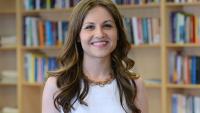Codruta Chiuzan

Assistant Research Scientist, Biostatistics
Dr. Chiuzan came to the United States as an exchange program math teacher. After three years teaching in South Carolina public high schools, she began graduate study at the Medical University of South Carolina, where she earned a PhD in Biostatistics. She studies the development of Phase I clinical trials with particular interest in cancer immunotherapeutic agents.
At Columbia’s College of Physicians and Surgeons’ Department of Surgery, she collaborates with clinicians looking to improve the quality of treatment and patient outcome. Dr. Chiuzan mentors Biostatistics master’s students and students from the Biostatistics Epidemiology Summer Training Diversity Program, Columbia Summer Institute for Training in Biostatistics, and Columbia Summer Research Institute.
What questions are you answering right now?
The growth in knowledge of cancer biology has led to the discovery of many promising anti-cancer agents, including immunotherapies, cancer vaccines, and adoptive T-cell transfer. My research considers early-phase clinical trials for establishing optimal dosage for new agents thought to be less harmful than chemotherapy or radiation therapy.
How do people find their way to Biostatistics?
I imagine many of our students travel a path similar to mine. The short answer? I was good at math. I’m a problem-solver. I wanted to help people. In Biostatistics, I’m able to put all of this together. A slightly longer answer is this: I am originally from Romania with an undergraduate background in pure math and an interest in medicine. But I was not enthralled with medicine or administering treatments or, frankly, blood. I preferred my medicine clean—data, computer programming, letting the data be the narrative. It took me about seven years from undergraduate to a master’s and a PhD to figure out that Biostatistics fits me best.
Are students likely to see themselves in that story?
I hope. That’s why I use so much of my own work in my Statistical Analysis Software class. Because I can already answer questions about what particular framework is important, it makes it much easier to motivate students. The truth is, students at Mailman are highly motivated and very hard working—really more than anywhere I’ve taught. That makes teaching them more difficult because they set the bar so high. I always want to bring in the best examples and present them eloquently.
What role do biostatisticians play in clinical research?
Biostatisticians want data to be as transparent as possible. Our field changed the way clinicians and basic scientists think about and analyze data. For example, in 1970, randomized clinical trials became the gold standard for evaluating therapies. Biostatisticians made a crucial contribution, developing the methods for designing and analyzing data from these studies. From there, biostatisticians needed to educate clinicians about the need for a statistical plan from the start. These days, we look not only at the final results, but at the statistical methods that were employed from the beginning.
That must make communication an important part of your collaboration.
Yes, and that‘s why we’re unique. Our expertise is not just in statistics. We have to have training or at least knowledge in the clinical discipline we’re working on to determine the right statistical method. And I must communicate effectively and with diplomacy. It can be difficult to address a faulty analysis or conclude statistical insignificance in project that cost millions. But the data say what the data say and nothing more.